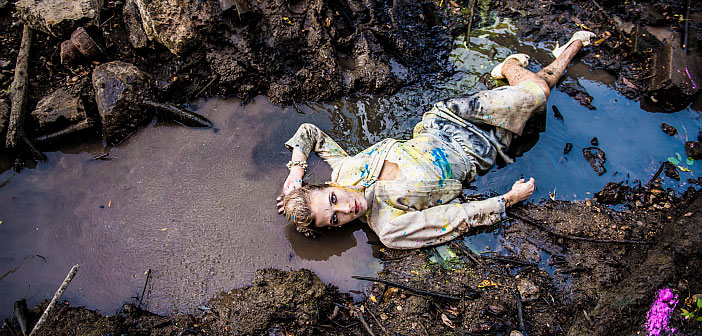Source: The Guardian
Investigators found severe environmental damage including water pollution from untreated contaminated waste, and air pollution.
Major fashion brands have been linked to viscose produced in polluting factories, according to a new report by the Changing Markets Foundation.Viscose, touted as a sustainable alternative to cotton or polyester, is often used as a cheaper and more durable alternative to silk, commonly in skirts and dresses. Experts say it is just as likely to be found in a £10 t-shirt as a £2,000 suit.
Investigators for the Changing Markets Foundation visited 10 manufacturing sites in China, India, and Indonesia, and found severe environmental damage including water pollution from untreated contaminated waste, and air pollution. Brands alleged by the report to source from these factories include H&M, Inditex (the owner of Zara), Marks & Spencer and Tesco.
Most of the brands contacted by the Guardian have acknowledged that the impacts of viscose production are an industry-wide problem and say they are exploring ways to produce more responsibly.
Also known as rayon, viscose is made from cellulose or wood pulp, often from soft woods like beech, pine and eucalyptus. “Although viscose is made from generally quick growing, regenerative trees,” says Renee Cuoco, manager of the Centre for Sustainable Fashion at the London College of Fashion, “the sustainability of the wood sources varies greatly.”
Viscose production is also chemical-heavy. Central to the process is carbon disulphide, a highly volatile and flammable liquid. The report cites evidence that carbon disulphide exposure is harming both factory workers and people living near viscose plants. The toxin has been linked to coronary heart disease, birth defects, skin conditions and cancer. Historically its use was found to cause severe mental health problems in rubber factory workers exposed to high levels of the toxin.
Other toxic chemicals used in the production of viscose include sodium hydroxide (caustic soda), and sulphuric acid.
The Changing Markets Foundation visited six manufacturing plants in China and said investigators found evidence of water and air pollution and severe health impacts on local communities. The report cites evidence in Jiangxi, a province in the southeast of China, that viscose production has contributed to the pollution of China’s largest freshwater lake, Poyang, killing aquatic life.
One of the plants visited in the eastern province of Shandong was the Shandong CHTC Helon Company which the Changing Markets Foundation says supplies H&M, Inditex (Zara), and Marks & Spencer.
The report alleges residential areas nearby to the factory are polluted with carbon disulphide levels three times higher than the permitted limit. According to the report, local people told investigators water from their well is now undrinkable due to pollution.
The Shandong Helon plant has faced criticism in the past for excessive emissions of air pollutants. It was highlighted by the Institute of Public and Environmental Affairs, the NGO set up by prominent Chinese environmentalist Ma Jun, as a company which regularly exceeds discharge standards.
Natasha Hurley, campaign manager at Changing Markets, blames fast fashion’s emphasis on volume and quick turnaround on product lines. “Clearly the viscose producers themselves have a huge responsibility here, but what has become increasingly clear is that retailers are putting huge pressure on producers and asking them to cut costs, cut delivery times – the pressure coming from the brands themselves is creating an unsustainable situation both on a social and environmental front.”
In response to the report, Ida Ståhlnacke for H&M told the Guardian it was deeply concerned at the findings and would “follow up with mentioned viscose producers that we source from.” H&M says the chemically intense nature of viscose production means it is an industry wide problem and that they are working with an external consultant to evaluate their supply chains.
A spokesperson for M&S said the company was concerned by the report and has the use of chemicals in viscose manufacturing firmly on its agenda: “We already encourage suppliers to produce more responsibly or more sustainably by incentivising them with an M&S accreditation if they do so. We know that there is much more to do though.”
A spokeswoman for Inditex spokeswoman said it works continuously with its suppliers to improve conditions and ensure that they adhere to sustainable practices. It says it will “publish our preferred viscose supplier list, according to compliance with our standards, at the end of this year.”
Tesco did not comment on its viscose suppliers, other than to say it does not source from Shandong CHTC Helon Company. A spokesman said the retailer is committed to zero discharge of hazardous chemicals: “we will continue to work closely with our suppliers on these issues.”
For Natasha Hurley at the Changing Markets Foundation, brands are not going far enough: “What we’ve seen with our investigation is that transparency doesn’t necessarily go hand in hand with more sustainable production.”
Hurley explains that while brands like Zara and H&M were very open about where they source viscose from, “that hasn’t translated into the factories they’re sourcing from being to a standard that we would expect. The whole reason for transparency in the first place is to stamp out human rights and environmental abuses.”
The report is calling for carbon disulphide to be completely eradicated from the viscose production process, and for all viscose production to occur in a closed loop system which eradicates chemical discharge and prevents harm to workers and the environment.
Tansy Hoskins is author of Stitched Up: The Anti-Capitalist Book of Fashion. She writes often on labour rights and the fashion industry. She is the subject of a Q&A in Issue 1 of Transform, a Journal of the Radical Left, which is reproduced here…

